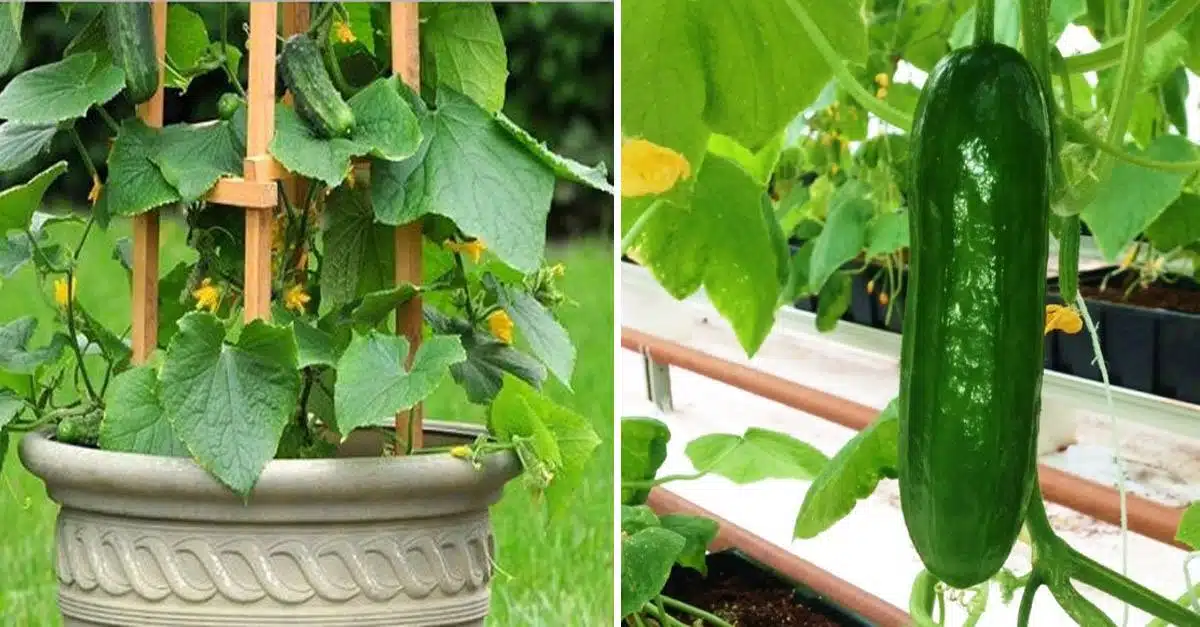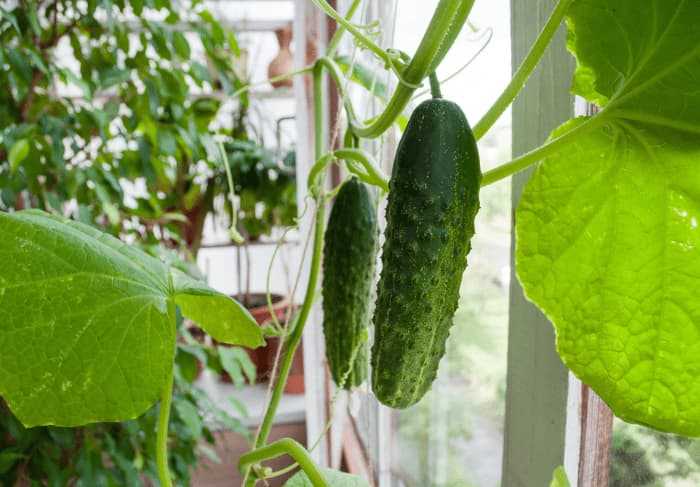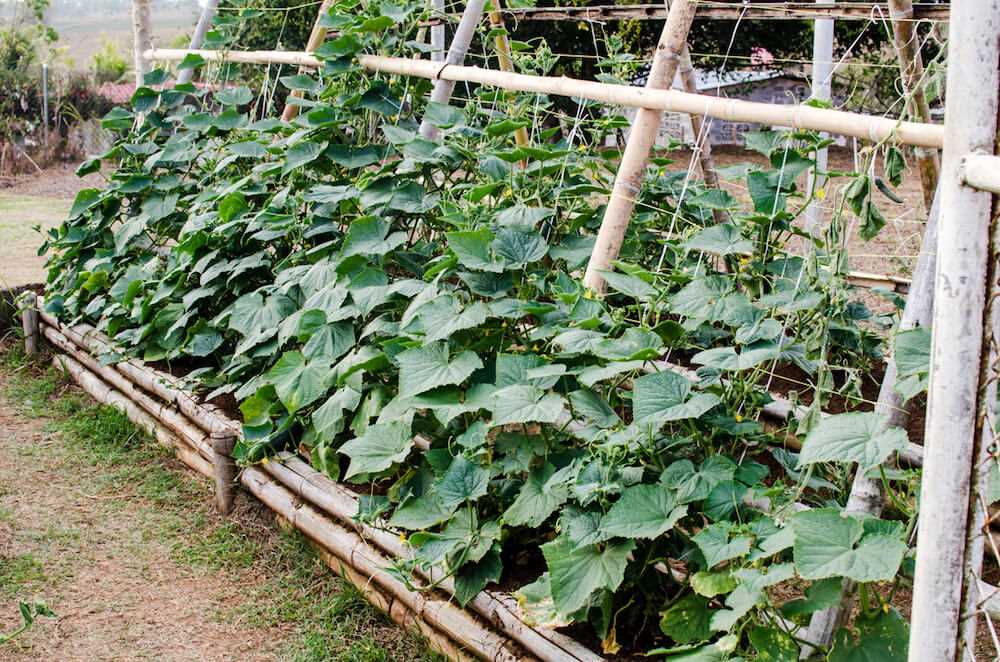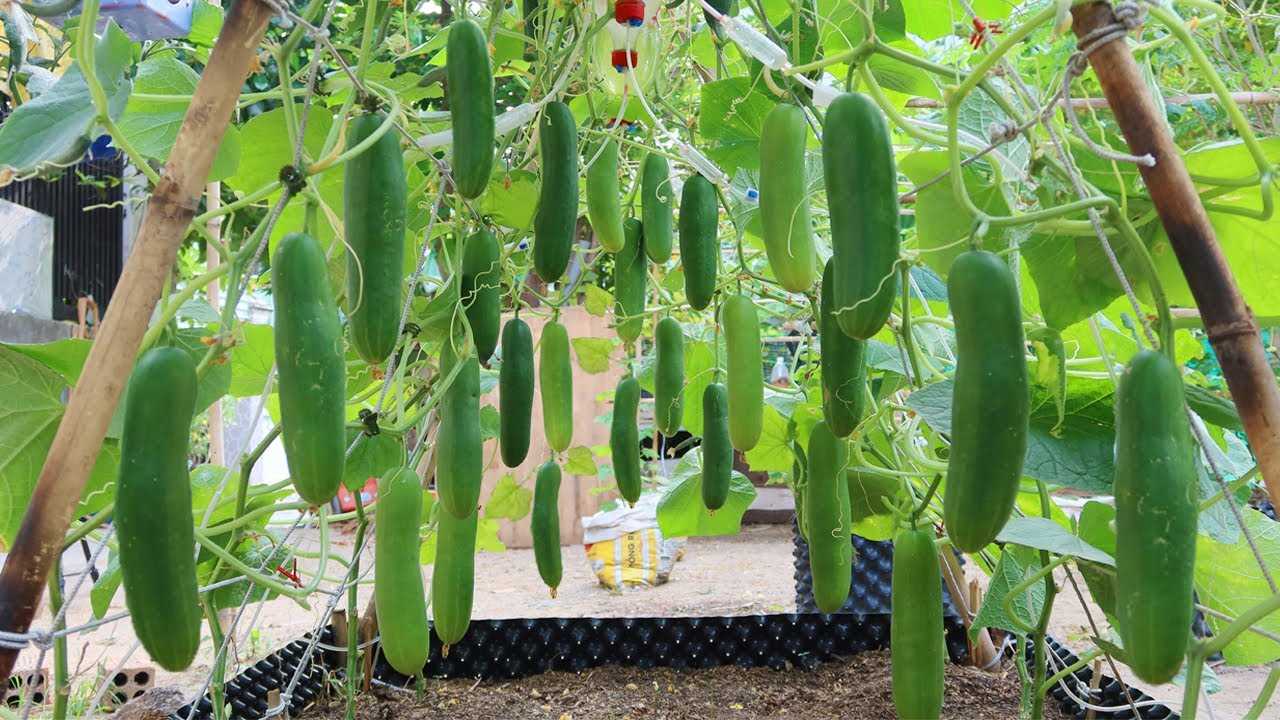- The Benefits of Vertical Way of Growing Cucumbers
- Gartering Techniques for Vertical Cucumber Growing
- 1. Choosing the Right Gartering Material
- 2. Properly Securing the Gartering Material
- 3. Regular Maintenance and Adjustments
- Shaping and Pruning Techniques for Vertical Cucumber Growing
- 1. Training cucumber vines
- 2. Removing lateral shoots
- 3. Pruning leaves
- 4. Controlling cucumber growth
- 5. Regularly inspect and maintain
- Watering Tips for Vertical Cucumber Growing
- Choosing the Right Cucumber Varieties for Vertical Growing
- Growth Habit
- Disease Resistance
- Flavor and Use
- Harvest Time
- Space Requirements
- Popular Cucumber Varieties for Vertical Growing
- Pest and Disease Control for Vertical Cucumber Growing
- 1. Aphids
- 2. Spider Mites
- 3. Powdery Mildew
- 4. Cucumber Beetles
- 5. Bacterial Wilt
- Harvesting and Maintaining Vertical Cucumber Plants
- Harvesting:
- Maintaining:
- “Question-Answer”
- What are some tips for vertical growing cucumbers?
- How can I train my cucumber plants to climb vertically?
- Can I use garters to support the growing cucumber plants?
- What is the benefit of vertical growing cucumbers?
- How often should I water vertically grown cucumber plants?
- “Video” HOW TO PRUNE YOUR CUCUMBER PLANTS FOR BEST PRODUCTION.
Growing cucumbers vertically has become increasingly popular among gardeners for its numerous benefits. By using a vertical support system, such as trellises or stakes, gardeners can maximize their limited space, reduce the chance of disease, and improve air circulation around the plants. In this article, we will explore some tips and techniques for successfully growing cucumbers vertically.
Gartering
One of the first steps in growing cucumbers vertically is gartering. Gartering involves tying the cucumber vines to a vertical support system to encourage them to grow upwards. This can be done with soft string or twine, being careful not to tie the vines too tightly. It is important to regularly check the gartering and adjust it as the plants grow to avoid any damage to the vines.
Shaping
Another technique for growing cucumbers vertically is shaping. Shaping involves pruning the cucumber plant to remove any side shoots or lateral branches that may compete for nutrients or shade the main stem. By shaping the plants, gardeners can create a more compact and focused growth pattern. This allows for better air circulation and light penetration, ultimately leading to healthier plants and higher yields.
Watering
Proper watering is crucial for successful vertical growing of cucumbers. As the water needs of vertically grown cucumbers may differ from those grown horizontally, it is important to monitor the moisture levels in the soil. Overhead watering should be avoided to prevent the leaves from becoming wet, which can increase the risk of fungal diseases. Instead, a drip irrigation system or watering directly at the base of the plants can help deliver water efficiently and prevent water wastage.
In conclusion, growing cucumbers vertically can be a rewarding and efficient way to cultivate this popular vegetable. By employing techniques such as gartering, shaping, and proper watering, gardeners can optimize their harvest and enjoy fresh cucumbers throughout the growing season. So, give vertical growing a try and see the difference it can make in your cucumber garden!
The Benefits of Vertical Way of Growing Cucumbers
Vertical way of growing cucumbers offers several benefits that make it a popular choice among gardeners. Here are some of the key advantages:
- Space-saving: Growing cucumbers vertically allows you to maximize the use of limited space. Instead of letting the cucumber vines sprawl on the ground, you can train them to grow upward using trellises, stakes, or other vertical structures. This is particularly advantageous for those who have small gardens or limited space.
- Increased air circulation: By growing cucumbers vertically, you can improve air circulation around the plants. This is crucial as good air circulation helps prevent the development of fungal diseases, such as powdery mildew, which often occur in dense and humid environments. Proper air circulation also helps the leaves dry faster after rain or irrigation, reducing the risk of foliar diseases.
- Better sunlight exposure: Cucumbers are sun-loving plants that require plenty of sunlight to thrive. Growing them vertically ensures better exposure to sunlight, as the leaves and fruits are lifted off the ground and have more access to direct sunlight. This can result in healthier plants and higher yields.
- Easier harvesting: Vertical growing makes cucumber harvesting easier, as the fruits are more visible and accessible. Instead of having to search through the leaves and vines on the ground, you can simply reach up and pluck the cucumbers. This not only saves time but also reduces the risk of damaging the plants during harvesting.
- Pest control: Vertical growing can help with pest control. Elevating the cucumber plants can deter some pests, such as slugs and snails, that tend to crawl on the ground. It also provides a better view of the plants, making it easier to spot and treat any pest infestations or diseases early on.
- Neater appearance: Vertical growing gives your cucumber plants a neater and more organized appearance. The vines are trained to grow upward, which reduces the sprawling and tangling that can occur with traditional ground-level cultivation. This not only improves the overall aesthetics of your garden but also makes it easier to manage and maintain the plants.
Overall, the vertical way of growing cucumbers offers several practical advantages, from space-saving and increased air circulation to easier harvesting and better pest control. Consider adopting this method in your garden to enjoy these benefits and maximize your cucumber harvest.
Gartering Techniques for Vertical Cucumber Growing
Vertical cucumber growing is a popular method that allows gardeners with limited space to still enjoy a bountiful cucumber harvest. One important aspect of vertical cucumber growing is gartering, which involves supporting the cucumber plants as they grow upwards.
1. Choosing the Right Gartering Material
When it comes to gartering cucumbers, there are several materials you can use. Some common options include:
- Garden Twine: This is a budget-friendly option that allows for easy adjustment as the cucumber plants grow.
- Garden Stakes: Stakes made of bamboo or wood can be used to provide vertical support to the cucumber plants. Make sure they are tall enough to accommodate the full height of the plants.
- Garden Netting or Trellis: Netting or trellis can be used to create a support structure for cucumber plants to climb. This option is especially useful if you have multiple cucumber plants in close proximity.
2. Properly Securing the Gartering Material
Once you have chosen the appropriate gartering material, it’s important to securely fasten it to prevent it from sagging or falling down. Here are some tips for securing the gartering material:
- Twine: Tie one end of the twine to a stake or support at the base of the cucumber plant. Gently guide the twine upwards as the cucumber plant grows, making sure it is taut but not too tight to allow for growth.
- Stakes: Insert stakes into the ground around the cucumber plants, ensuring they are positioned close to the base of the plants. Tie the cucumber vines loosely to the stakes using twine or garden clips.
- Netting or Trellis: Attach the netting or trellis to sturdy posts or a frame, making sure it is taut and securely anchored. As the cucumber plants grow, gently weave the vines through the netting or trellis to provide support.
3. Regular Maintenance and Adjustments

As the cucumber plants grow, it’s important to regularly check and adjust the gartering material. This will ensure that the plants are properly supported and can grow vertically without any issues. Here are some maintenance and adjustment tips:
- Loosen or tighten: Check the tension of the gartering material and adjust it as needed. Loosen any ties that may be too tight or tighten any that may have become loose.
- Prune excess growth: Remove any extra side shoots or tendrils that may be weighing down the cucumber plants or obstructing their vertical growth.
- Monitor plant growth: Regularly inspect the plants to ensure they are growing vertically and make any necessary adjustments to the gartering material.
By using the right gartering techniques, you can successfully grow cucumbers vertically and maximize your space. Remember to choose the appropriate gartering material, securely fasten it, and regularly maintain and adjust it as the cucumber plants grow.
Shaping and Pruning Techniques for Vertical Cucumber Growing
Growing cucumbers vertically can help maximize space and increase yields. To achieve successful vertical cucumber growth, it is important to use shaping and pruning techniques. These techniques promote airflow, reduce disease, and help cucumbers grow in a controlled manner.
1. Training cucumber vines
- Start by providing a trellis or structure for the cucumber vines to climb. This can be a simple stake or a more elaborate trellis system.
- Gently train the main cucumber vine to grow vertically by tying it to the trellis using soft plant ties or twine. Be careful not to constrict the vine or cause damage.
- As the cucumber vines grow, continue to guide them upward by tying them to the trellis. This will prevent them from sprawling on the ground and taking up unnecessary space.
2. Removing lateral shoots
- Lateral shoots, also known as suckers or side branches, can divert energy from the main vine and reduce overall cucumber production.
- Regularly check the cucumber plant for lateral shoots and carefully remove them by pinching or cutting them off at their base using clean pruning shears or scissors.
- Focusing the plant’s energy on the main vine will promote stronger growth and larger cucumbers.
3. Pruning leaves
- Cucumber plants tend to have a dense foliage, which can restrict airflow and create a humid environment ideal for disease development.
- Selectively remove some of the lower leaves to increase airflow and reduce the chances of fungal diseases.
- Prune leaves that show signs of disease or damage to prevent further spread.
4. Controlling cucumber growth
- If the cucumber plant grows too vigorously, it may become difficult to manage and control.
- To limit excessive growth, pinch or prune off the growing tip of the main vine once it reaches the desired height. This will encourage lateral branching and the production of more cucumbers.
5. Regularly inspect and maintain
- Regularly inspect the cucumber plant for any signs of pests or diseases.
- Remove any dead or diseased leaves or fruit to prevent the spread of pathogens.
- Water the cucumber plant regularly and efficiently to ensure healthy growth.
By implementing these shaping and pruning techniques, you can optimize the growth and productivity of your vertically grown cucumbers. Remember to adapt these techniques based on the specific needs of your cucumber variety and growing conditions.
Watering Tips for Vertical Cucumber Growing
Proper watering is essential for successful vertical cucumber growing. Here are some tips to ensure your cucumber plants receive the right amount of water:
- Consistent watering: Cucumbers require consistent moisture to grow properly. Water your plants regularly to keep the soil consistently moist, but not waterlogged. Avoid letting the soil dry out completely, as this can cause stress to the plants.
- Avoid overhead watering: When watering your vertical cucumber plants, it’s best to avoid overhead watering. Instead, water at the base of the plants to minimize the risk of disease and fungal growth. Use a watering can or a soaker hose to deliver water directly to the roots.
- Adequate drainage: Ensure that your vertical cucumber containers have adequate drainage holes. This will help prevent water from pooling and causing root rot. It’s also a good idea to use a well-draining soil mix specifically formulated for container gardening.
- Watering schedule: Develop a watering schedule based on the needs of your cucumber plants and the climate in your area. Generally, cucumbers require about 1-2 inches of water per week. However, during hot and dry periods, they may need more frequent watering.
- Mulching: Apply a layer of organic mulch around the base of your vertical cucumber plants. Mulch helps to retain soil moisture, regulate soil temperature, and suppress weed growth. This can reduce the frequency of watering and help maintain a more consistent moisture level.
- Monitor soil moisture: Regularly check the moisture level of the soil by sticking your finger about an inch deep. If it feels dry, it’s time to water. If it feels wet or moist, hold off on watering until the soil has dried out slightly.
- Watering in the morning: Water your vertical cucumber plants in the morning so that the foliage has enough time to dry before evening. Wet leaves during the night can increase the risk of disease and fungal problems.
By following these watering tips, you can ensure that your vertical cucumber plants receive the right amount of water to thrive and produce a bountiful harvest.
Choosing the Right Cucumber Varieties for Vertical Growing
Growing cucumbers vertically can be a great way to maximize space and increase yields in your garden. Choosing the right cucumber varieties is an important factor in the success of your vertical growing system. Here are a few factors to consider when selecting cucumber varieties for vertical growing:
Growth Habit

- Vining cucumbers: These varieties have long vines that can grow several feet tall. They require a sturdy trellis or support system to climb on.
- Bush cucumbers: These varieties have a more compact growth habit and don’t require as much vertical space. They may still benefit from a trellis for support.
Disease Resistance
Cucumber plants can be susceptible to various diseases such as powdery mildew, cucumber mosaic virus, and downy mildew. Look for cucumber varieties that are known for their disease resistance to minimize the risk of your plants getting infected.
Flavor and Use
Consider the flavor and use of the cucumber variety you are choosing. Some cucumbers are best for fresh eating, while others are better suited for pickling. Determine your preferred use for cucumbers and select varieties accordingly.
Harvest Time
Cucumber varieties have different days to maturity, ranging from 50 to 70 days on average. If you have a short growing season, choose cucumber varieties with a shorter maturity time to ensure you can harvest your cucumbers before the first frost.
Space Requirements
Consider the vertical space you have available and choose cucumber varieties that will fit well within your garden. Vining cucumbers will require a taller trellis or support structure, while bush cucumbers can be grown in containers or smaller garden plots.
Popular Cucumber Varieties for Vertical Growing
| Variety | Growth Habit | Days to Maturity | Flavor/Use |
|---|---|---|---|
| Telegraph Improved | Vining | 55-60 days | Fresh eating, pickling |
| Burpless Bush Hybrid | Bush | 50-55 days | Fresh eating, slicing |
| Patio Snacker | Bush | 55-60 days | Snacking, container gardening |
These are just a few examples of cucumber varieties that are suitable for vertical growing. It’s always best to consult seed catalogs or local nurseries for varieties that are specifically recommended for vertical gardening in your region.
By carefully selecting cucumber varieties that match your growing conditions and preferences, you can achieve a successful vertical cucumber garden and enjoy a bountiful harvest.
Pest and Disease Control for Vertical Cucumber Growing
When growing cucumbers vertically, it is important to implement proper pest and disease control measures in order to ensure a successful harvest. Here are some tips and techniques to help you manage common pests and diseases:
1. Aphids
Aphids are small, soft-bodied insects that feed on plant sap and reproduce quickly. They can cause stunted growth and transmit viral diseases to your cucumber plants. To control aphids:
- Inspect your plants regularly for signs of aphid infestation, such as curled leaves or sticky residue.
- If you spot aphids, spray them with a strong blast of water from a hose to dislodge them.
- Alternatively, use an insecticidal soap or neem oil to kill aphids. Follow the instructions on the product label.
2. Spider Mites
Spider mites are tiny pests that suck sap from cucumber plants, causing yellowed leaves and webbing. To control spider mites:
- Regularly spray your plants with water to help prevent mite infestations.
- If mites are present, use an insecticidal soap or neem oil to kill them. Repeat the application as needed.
- Introduce natural predators, such as ladybugs or predatory mites, to help control mite populations.
3. Powdery Mildew

Powdery mildew is a fungal disease that appears as a white, powdery coating on cucumber leaves. It can reduce plant vigor and yield. To control powdery mildew:
- Ensure good air circulation around your plants by spacing them properly and pruning any dense growth.
- Avoid overhead watering, as moisture on the leaves can contribute to the development of powdery mildew.
- If powdery mildew is present, apply a fungicide labeled for cucumbers. Follow the product instructions carefully.
4. Cucumber Beetles

Cucumber beetles are small, yellow-green insects that feed on cucumber leaves, flowers, and fruits. They can transmit bacterial wilt disease. To control cucumber beetles:
- Inspect your plants regularly for the presence of adult beetles, as well as their eggs and larvae.
- Handpick adult beetles and larvae and drop them into a bucket of soapy water to kill them.
- Consider using row covers or insect netting to physically exclude cucumber beetles from your plants.
5. Bacterial Wilt
Bacterial wilt is a disease that is spread by cucumber beetles and causes wilting and death of cucumber plants. To control bacterial wilt:
- Monitor your plants closely for any signs of wilt, such as wilting leaves that do not recover even after watering.
- If bacterial wilt is suspected, remove and destroy affected plants to prevent the spread of the disease.
- Consider rotating your cucumber crops to different locations each year to reduce the risk of bacterial wilt.
By implementing these pest and disease control measures, you can help ensure a healthy and productive vertical cucumber growing season.
Harvesting and Maintaining Vertical Cucumber Plants
Growing cucumbers vertically has many benefits, including maximizing space and improving air circulation around the plants. But once your cucumber plants start growing vertically, how can you ensure a successful harvest and maintain their health? Here are some tips and techniques:
Harvesting:
- Check your cucumber plants regularly for ripe cucumbers. Cucumbers are ready to be harvested when they are firm, have a bright green color, and reach the desired size.
- Use sharp garden shears or a knife to cut the cucumbers off the vine. Be careful not to damage the plant while harvesting.
- Harvest cucumbers early in the morning when the temperatures are cooler for better flavor and to reduce the risk of wilting.
- If you’re growing cucumbers for pickling, harvest them when they are smaller and have a bumpy skin.
- Regularly remove any overripe or damaged cucumbers from the plant to prevent diseases from spreading.
Maintaining:
- Keep an eye on the vertical supports and make sure they are sturdy enough to support the growing cucumbers. Adjust or reinforce the supports as needed.
- Trim any side shoots or suckers that grow from the main stem of the cucumber plant. This will redirect the plant’s energy towards producing more cucumbers.
- Regularly check for pests, such as aphids or cucumber beetles, and take appropriate measures to control them. Insecticidal soaps or natural predators can be used for organic pest control.
- Water your vertical cucumber plants regularly, especially during hot and dry periods. Make sure the soil is evenly moist but not waterlogged.
- Consider using a layer of mulch around the base of the plants to help retain moisture and suppress weed growth.
- Fertilize your cucumber plants with a balanced fertilizer according to the package instructions. This will provide them with the necessary nutrients for healthy growth and maximum yields.
- Monitor the health of your cucumber plants and watch out for any signs of diseases, such as powdery mildew or bacterial wilt. Promptly remove and discard any affected plants to prevent the spread of diseases.
By following these tips and techniques, you can ensure a bountiful harvest of delicious cucumbers and maintain the health of your vertical cucumber plants throughout the growing season.
“Question-Answer”
What are some tips for vertical growing cucumbers?
There are several tips for vertical growing cucumbers. Firstly, you need to ensure you have a sturdy support system, such as trellises or stakes, for the plants to climb. Secondly, pruning the side shoots will help keep the plant focused on growing upwards. Additionally, you should regularly tie the cucumber vines to the support structure to prevent them from drooping or breaking. Finally, make sure to provide adequate water and fertilizer to support the plants’ growth.
How can I train my cucumber plants to climb vertically?
To train your cucumber plants to climb vertically, you can use trellises, stakes, or cages. Place the supports firmly in the ground near the cucumber plants and gently guide the vines to grow up the structure. As the plants continue to grow, you may need to tie the vines to the support system to keep them in place. Regularly check and adjust the position of the vines to ensure they are growing vertically.
Can I use garters to support the growing cucumber plants?
Yes, you can use garters to support the growing cucumber plants. Garters are commonly used for vertical gardening to secure the plants and help them grow upward. Simply wrap the garters around the vines and attach them to a support structure, such as stakes or trellises. Make sure to tie the garters firmly but not too tightly, as the vines need room to grow and expand.
What is the benefit of vertical growing cucumbers?
Vertical growing cucumbers offer several benefits. Firstly, it maximizes the use of limited space, making it ideal for small gardens or urban settings. Secondly, growing cucumbers vertically helps improve air circulation, reducing the risk of diseases and pests. It also makes it easier to spot and harvest ripe cucumbers. Additionally, vertical growing can result in straighter cucumbers as the fruit grows off the ground, reducing the chances of deformities or rot.
How often should I water vertically grown cucumber plants?
The frequency of watering vertically grown cucumber plants can vary depending on the weather and soil conditions. Generally, it is recommended to water the plants deeply once or twice a week. However, it is crucial to monitor the soil moisture levels and adjust the watering schedule accordingly. The soil should be evenly moist but not waterlogged. Mulching around the plants can help retain moisture and reduce evaporation.







